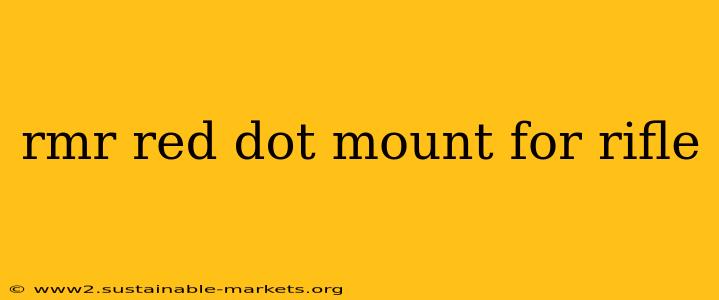Choosing the right red dot mount for your rifle can significantly impact your shooting accuracy and overall experience. The Trijicon RMR (Ruggedized Miniature Reflex sight) is a popular choice for its durability and performance, but selecting the appropriate mount is crucial. This guide explores various RMR red dot mounts for rifles, helping you make an informed decision.
Understanding RMR Mounts and Their Significance
An RMR mount acts as the bridge between your rifle's optic rail and your red dot sight. Its purpose extends beyond simple attachment; it dictates the height of the sight above the bore, influencing your cheek weld and zeroing process. A poorly chosen mount can lead to discomfort, inaccurate shots, and even damage to your equipment. Key factors to consider include:
-
Height: The height of the mount determines the sight picture and how it aligns with your rifle's iron sights (if used). Lower mounts provide a lower profile, while higher mounts offer greater clearance for larger optics or backup iron sights.
-
Material: Durable materials like aluminum are preferred for their strength and resistance to wear and tear. Steel offers even greater durability but adds weight.
-
Compatibility: Ensure the mount is compatible with both your specific RMR model (various footprints exist) and your rifle's rail system (e.g., Picatinny, Weaver).
-
Locking Mechanism: A secure and reliable locking mechanism is vital to prevent the sight from shifting during recoil. Look for mounts with robust locking screws or levers.
Types of RMR Mounts for Rifles
Several types of RMR mounts cater to different needs and preferences:
1. Low Profile Mounts:
These mounts sit close to the rail, offering a low profile for a streamlined setup. They are ideal for applications where a low sight picture is desired, but might require careful consideration of clearance for backup iron sights.
2. Absolute Co-Witness Mounts:
Designed for use with backup iron sights, these mounts provide a clear view of both the red dot and the iron sights. This is particularly useful in situations where the red dot malfunctions.
3. Lower 1/3 Co-Witness Mounts:
These mounts offer a lower 1/3 co-witness, meaning the iron sights are visible through the bottom third of the red dot's window. This provides a backup aiming solution without significantly obscuring the red dot.
4. Direct Mount Options:
Some manufacturers offer direct mounts that eliminate the need for an adapter plate. These mounts provide a potentially more rigid connection between the sight and the rail.
Choosing the Right RMR Mount: Key Considerations
The optimal RMR mount depends largely on individual needs and preferences. However, some key considerations remain consistent:
-
Rifle Type: The type of rifle significantly influences mount selection. For example, an AR-15 might benefit from a lower 1/3 co-witness mount, while a larger platform rifle might need a higher mount for clearance.
-
Shooting Style: Precision shooting often favors lower mounts for a stable sight picture. More dynamic shooting might benefit from higher mounts to allow for a quicker target acquisition.
-
Personal Preference: Ultimately, the most comfortable and effective setup is subjective. Consider trying different mounts to find the one that suits your personal ergonomics and shooting style.
Maintaining Your RMR Mount
Proper maintenance of your RMR mount is crucial to ensure its longevity and reliability. Regularly inspect the locking screws and mechanisms for any signs of wear or looseness. Clean the mount after each use to prevent dirt and debris from accumulating and potentially affecting its performance.
Conclusion: Finding the Perfect Fit
Selecting the right RMR red dot mount for your rifle is a critical decision that impacts accuracy, comfort, and overall shooting experience. By carefully considering the factors discussed in this guide and taking the time to research different options, you can ensure a reliable and effective setup tailored to your specific needs. Remember to always prioritize safety and proper handling of firearms.

